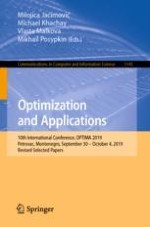2020 | OriginalPaper | Buchkapitel
Polynomial-Time Solvability of One Optimization Problem Induced by Processing and Analyzing Quasiperiodic ECG and PPG Signals
verfasst von : Alexander Kel’manov, Sergey Khamidullin, Liudmila Mikhailova, Pavel Ruzankin
Erschienen in: Optimization and Applications
Aktivieren Sie unsere intelligente Suche, um passende Fachinhalte oder Patente zu finden.
Wählen Sie Textabschnitte aus um mit Künstlicher Intelligenz passenden Patente zu finden. powered by
Markieren Sie Textabschnitte, um KI-gestützt weitere passende Inhalte zu finden. powered by
